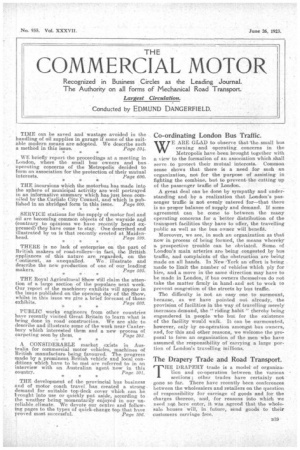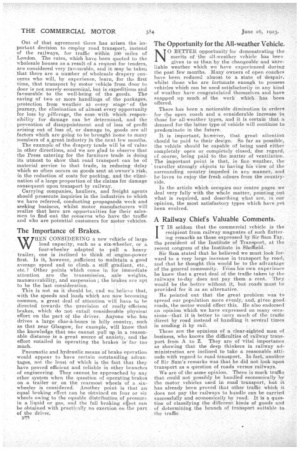Co-ordinating London Bus Traffic.
Page 1

Page 2

If you've noticed an error in this article please click here to report it so we can fix it.
WE ARE GLAD to observe that the small bus , owning and operating concerns in the Metropolis have been brought together with a view to the form-ation of an association which shall serve to protect their mutual interests. Common sense shows that there is a need for such an organization, not for the purpose of assisting in fighting the combine, but to prevent, the cutting up of the passenger traffic of London.
A great deal can be done by sympathy and understanding and by a realization that London's passenger traffic is not evenly catered 'for—that there is no proper balance of Supply and demand. if some agreement can be come to between the many operating concerns for a better distribution of the transport facilities they have to offer, the travelling public as well as the bus owner will benefit.
Moreover, we see, in such an organization as that now in process of being formed, the means whereby a prospective trouble can be obviated. Some of London's main arteries are being congested by bus traffic, and complaints of the obstruction are being made on all hands. In New -York an effort is being made to limit the number of vehicles which ply for hire, and a move in the same direction may have to be made in London, if bus owners themselves do not take the matter firmly in hand.and set to work to prevent congestion of the streets by bus traffic.
The difficulty is not an easy one to surmount, because, as we have pointed out already, the provision of facilities in the way of travelling merely increases demand, the "riding habit" thereby being engendered in people who but for the existence of the facility would walk. It can be surmounted, however, only by co-operation amongst bus owners, and, for this and other reasons, we welcome the proposal to form an organization of the men who have assumed, the responsibility of carrying a large portion of London's travelling millions.
The Drapery Trade and Road Transport.
THE DRAPERY trade is a model of organizaVion and co-operation between the various sections; other trades have certainly not gone so far. There have recently been conferences between the wholesalers and retailers on the question of responsibility for carriage of goods and for the charges thereon, and, for reasons into which we need net here enter, it was agreed that the whalesale houses will, in future, send goods to their customers carriage free. Out of that agreement there has arisen the hnportant decision to employ road transport, instead of the railways, for traffic within 100 miles of London. The rates, which have been quoted to the wholesale houses as a result of a request for tenders, are considered very favourable, and it may. be taken that there are a number of wholesale drapery concerns who will, by experience, learn, for the first time, that transport by motor vehicle from door to door is not merely econornieal, but is expeditious and favourable to the well-being of the goods. The saving of two or more handlings of the packages, protection from weather at every • stageof the journey, the elimination of almost every opportunity for loss by pilferage., the ease with which responsibility for damage can be determined, and the prevention of disappointment and of loss of profit arising out of loss of, or damage to, goods are all factors which are going to be brought home to many members of agreat industry in the next few months. The example of the drapery trade will he of value in other directions, and we are glad to observe that the Press catering for the furniture trade is doing its utmost to show that road transport can be of material service to that trade, in reducing delay which so often occurs on goods sent at owner's risk, in the reduction of costs for packing, and the elimination of a large proportion of the claims for damage consequent upon transport by railway. Carrying companies, hauliers, and freight agents should prosecute inquiries in the industries to which we have referred, conducting propaganda work and seeking business, whilst motor manufacturers will realize that here are opportunities for their salesmen to find out the concerns who have the traffic and who are potential customers for motor vehicles.
The Importance of Brakes.
WHEN CONSIDERING a new vehicle of large load capacity; such as a six-wheeler, or .a four-wheeler adapted to pull a heavy trailer, one is inclined to think of engine-power first. Is it, however, sufficient to -maintain a good average speed and to climb. a stiff gradient, etc., etc. ? Other points which conic in for immediate attention are the transmission, axle weights, manoeuvrability, and suspension ; the brakes are apt
to be the last consideration. • '
This is not as it should be, and we believe that, with the speeds and loads which are now becoming common, a great deal of attention will have to be directed towards the provision of really efficient brakes, which do not entail considerable physical effort on the part of the driver. AnYmie who has driven a large char-a-bancs in hilly country, such as that near Glasgow, for example, will know that the knowledge that one cannot pull up in a reasonable distance is a. great source of anxiety, and the effort entailed in operating the brakes is far too much.
Pneumatic and hydraulic means of brake operation would appear to have certain outstanding advantages, not the least of which is the fact that they have proved efficient and reliable in other branches of engineering. They cannot be approached by any other system when the question of operating brakes on ,a trailer or. on the rearmost wheels of a sixwheeler is considered. Another point is that an equal braking effect can be obtained on four or six wheels owing to the equable distribution of pressure in a liquid or gas, and the full braking effect can be obtained with 'practically no exertion on the part of the driver.
The Opportunity for the All-weather Vehicle.
N. 0 BETTER opportunity for demonstrating the merits of the all-weather vehicle has been given to us than by the changeable and unreliable weather which we have experienced during the past few months. Many owners of open coaches have been reduced almost to a state of despair, whilst those who are fortunate enough to possess vehicles which can be used satisfactorily in any kind of weather have congratulated themselves and have snapped up much of the work which has • been offered.
There has been a noticeable diminution in orders for the open coach and a considerable increase in those for all-Nveather types, and it is certain that a demand for the latter type of vehicle will continue to
predominate in the future. .
It is important, however, that great attention 'should be paid to their design. So far as possible, the vehicle should be capable of being used either completely open or completely closed, due regard, ef course, being paid to the matter of ventilation. . The important point is that, in film weather, the traveller strongly objects to having his view of the surrounding country impeded in any mannea, and he loves to enjoy the fresh odours from the country
side. .
In the article which occupies our centre pages we deal very funk with the whole matter, pointing out what is required, and describing what are, in our Opinion, the most satisfactory types which have .yet been evolved.
A Railway . Chief's Valuable Comments. .
IT IS seldom that the commercial vehicle is the recipient from railway magnates of such flatterbig remarks as those expressed by Sir Sam Fay, the president of the Institute of Transport, at the recent congress of the Institute in Sheffield. Sir Sam stated that he believed we must look forward to a very large increase in transport by road, and that he thought this would be to the advantage of the general community. Fiona his own experience he knew that a great, deal of the traffic taken by the railways to-day does not pay them a cent. They would be the better without it, but roads must be
provided for it as an alternative. ,
He pointed out that the great problem was to spread our Ovulation more evenly, and, given good. roads, the motor would effect this. He also endorsed an opinion which we have expressed on many oecasions—that it is better to carry much of the traffic direct by road instead of handling it several times in sending it by rail. These are' the opinions of a clear-sighted man of business, who knows the difficulties of railway transport from A. to Z. They are of vital importance as showing that the deep thinkers in railway administration are inclined to take a reasonable attitude with regard to road transport. In fact, another of Sir Sam's remarks was that he did not look upon transport as a question of roads versus railways. We are of the same opinion. There is much traffie that could not possibly be handled economically by the motor vehicles used in road transport, but it has already been proved that other traffic which it does not pay the railways to handle can be carriel successfully and economically by road. It 'is a question of classifying the different kinds of goods and of determining the branch of transport suitable to the traffic




























